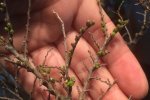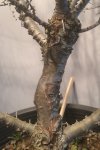ColinFraser
Masterpiece
In addition to a field grown Trident Maple, I picked up this Seiju Elm at Muranaka's yesterday.

It had a decent little flare at the base, and was just starting to push buds at the top.

Unfortunately, just above those lowest "slingshot" branches it gets pretty awkward - especially the big bulge where most of the upper branches emerge.

I thought about an air layer, but decided the whole reason I was going to chop it is that I don't like that section; why would I spend more energy and time making a whole new tree out of the worst part of this one? I will try to grow the individual branches as cuttings though.

So, I cut back to a low branch that I hope will add movement and taper. I loosely wired it upward just a bit to smooth the curve out some. What do you think?
I guess the plan now is to let the new leader grow and thicken some, to heal the chop and smooth the transition. At the same time, I'll be hoping for a new bud to make a branch somewhere near the outside of that corner . . .

It had a decent little flare at the base, and was just starting to push buds at the top.

Unfortunately, just above those lowest "slingshot" branches it gets pretty awkward - especially the big bulge where most of the upper branches emerge.

I thought about an air layer, but decided the whole reason I was going to chop it is that I don't like that section; why would I spend more energy and time making a whole new tree out of the worst part of this one? I will try to grow the individual branches as cuttings though.

So, I cut back to a low branch that I hope will add movement and taper. I loosely wired it upward just a bit to smooth the curve out some. What do you think?
I guess the plan now is to let the new leader grow and thicken some, to heal the chop and smooth the transition. At the same time, I'll be hoping for a new bud to make a branch somewhere near the outside of that corner . . .




